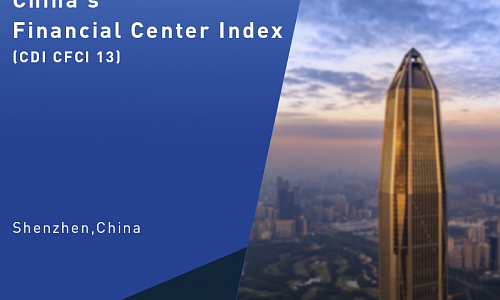Public Welfare, Finance and Goodness Economy
 The book is aimed at promoting the integration of philanthropy, finance and economy. The summary of and analysis on philanthropic experience is centered on how the economic and social development can generate public welfare for people’s livelihood.
The book is aimed at promoting the integration of philanthropy, finance and economy. The summary of and analysis on philanthropic experience is centered on how the economic and social development can generate public welfare for people’s livelihood.
China Financial Center Index 9 (CDI CFCI 9)
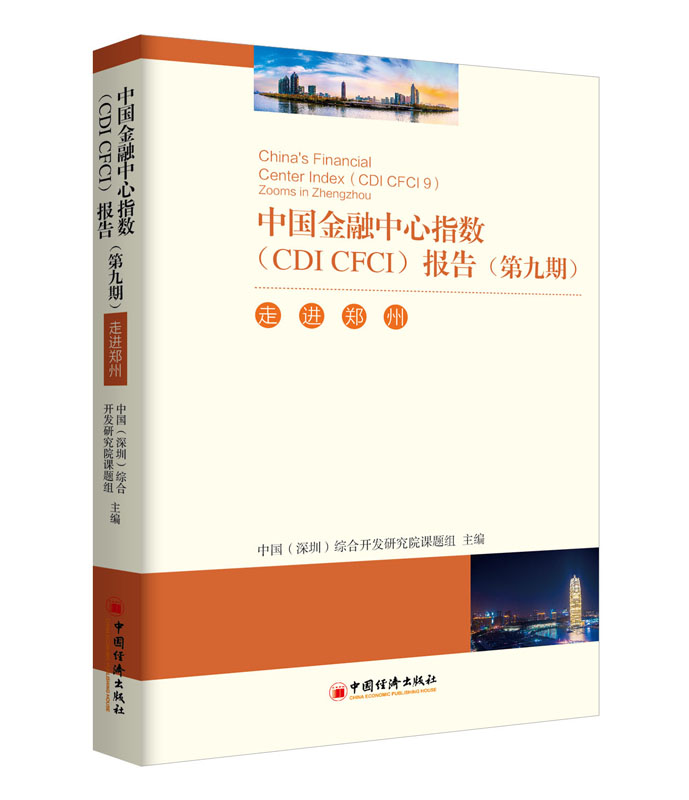 The CFCI 9 comprehensively evaluates 31 financial centers of China, using 88 indicators in the four broad areas of financial industry performance, financial institutions’ competitiveness, financial market size and financial dynamics. Since it was first released in 2009, the CFCI has been updated annually. The index shows that the 31 cities create 52% of the total value in financial services in China and own 81% of the total asset of commercial banks in China, 96% of the total asset of brokerage firms in China and 96% of the total asset of insurance companies in China.
The CFCI 9 comprehensively evaluates 31 financial centers of China, using 88 indicators in the four broad areas of financial industry performance, financial institutions’ competitiveness, financial market size and financial dynamics. Since it was first released in 2009, the CFCI has been updated annually. The index shows that the 31 cities create 52% of the total value in financial services in China and own 81% of the total asset of commercial banks in China, 96% of the total asset of brokerage firms in China and 96% of the total asset of insurance companies in China.
China Entrepreneurship and Innovation Finance Index Report 2017
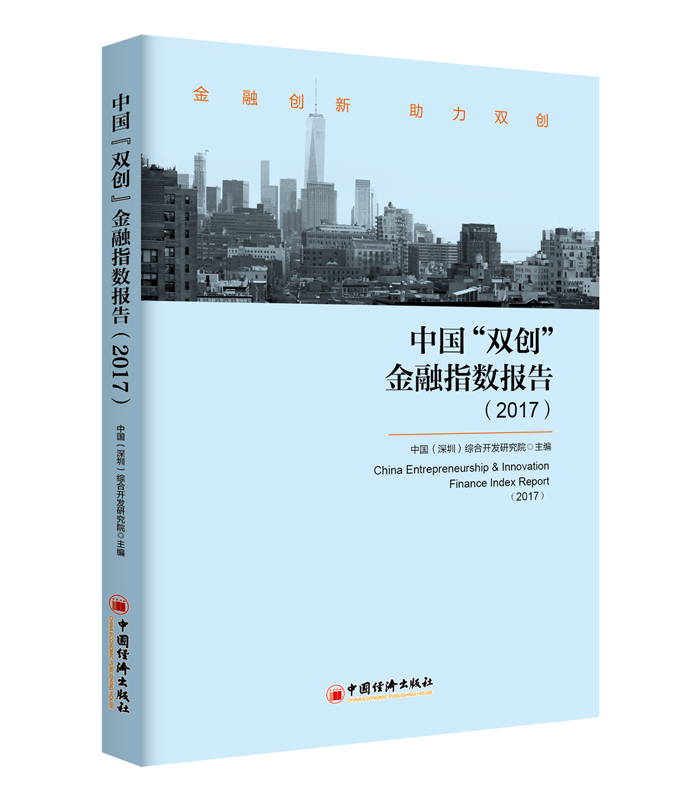 China Entrepreneurship and Innovation Finance Index measures financial services supporting entrepreneurship and innovation in 31 major cities of China through 46 indicators.
China Entrepreneurship and Innovation Finance Index measures financial services supporting entrepreneurship and innovation in 31 major cities of China through 46 indicators.
CDI Experts Share the Experience of and Challenges for China’s Urbanization with CPR Expert
On January 12, Dr. Partha Mukhopadhyay from Centre for Policy Research visited CDI to learn the experience of and challenges for China’s urbanization and share the experience of Indian pharmaceutical industry. Senior Research Fellow Dr. Ruan Meng and Ms. Feng Yueqiu, Director of International Cooperation from CDI introduced industrial transformation and urban development of Shenzhen and the status quo of the Guangdong-Hong Kong-Macao Greater Bay Area, while Dr. Partha Mukhopadhyay introduced India’s flexible and inclusive regulations related to the pharmaceutical industry which enable the access to affordable and effective drugs for low-income people.
CDI,Chicago Council on Global Affairs, Bay Area Council Economic Institute and Asia Pacific Foundation of Canada Jointly Host Seminars in North America
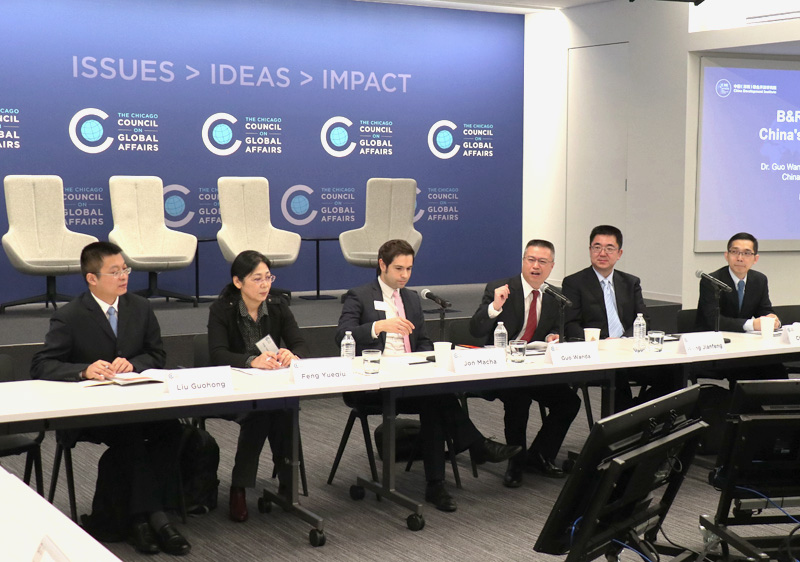
CDI, Chicago Council on Global Affairs, Bay Area Council Economic Institute and Asia Pacific Foundation of Canada jointly hosted seminars themed on “Belt and Road” Initiative, the development of bay area and financial innovation. With the purpose of introducing the circumstance of CDI delegation paid visits to three cities including Chicago, San Francisco and Vancouver from December 10 to 17
On December 11, CDI and Chicago Council on Global Affair jointly hosted a seminar themed on “China is changing the future of the world” in Chicago. In the seminar, CDI delegates deemed that the international cooperation model should encourage overseas companies' entry to China and Chinese companies' expansion abroad with the main focus on the “Belt and Road” Initiative. On one hand, the cooperation seeks the mutual benefits with countries along the “Belt and Road” through promoting the cooperation on infrastructure construction, public education, policy making and etc. On the other hand, the “Belt and Road” Initiative encourages to integrate national strategies and plans with developed countries. The other participants had profounder understanding on the “Belt and Road” Initiative through the seminar.
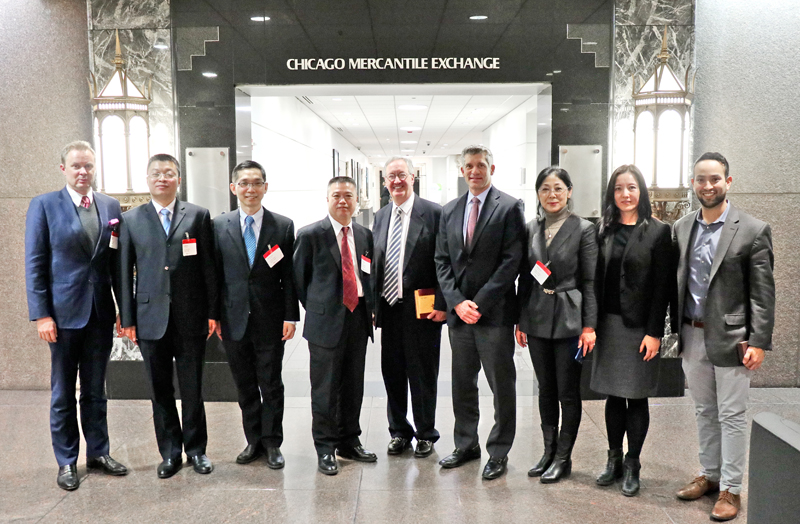
With the idea of exchanging the experience of bay area development, CDI also hosted World Bay Area’s Development Seminar with Bay Area Council Economic Institute on December 13 in San Francisco. Dr. Sean Randolph, senior director of Bay Area Council Economic Institute, shared the experience of the San Francisco Bay Area in building a global innovation center while Dr. Guo Wanda from CDI analyzed the significance of the establishment of Guangdong-Hong Kong-Macao Great Bay Area and Shenzhen. CDI delegation visited Asia Pacific Foundation of Canada and discussed the development of the “Belt and Road” initiative on December 15 in Vancouver. CDI delegates talked about the prospect of RMB Internationalization under “Belt and Road” initiative. What is more, two institute exchanged the views of the policy mechanism of Hong Kong under the “One Country, Two System” policy.
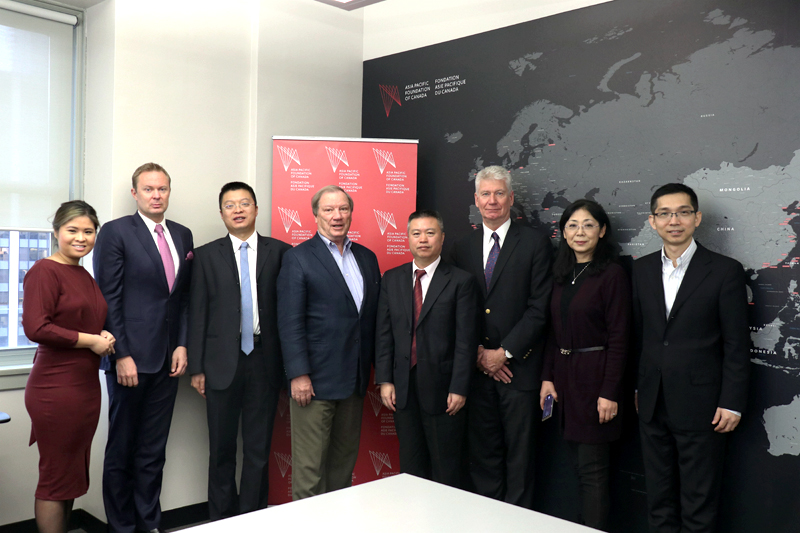
The tour expanded the business connection with international financial institutes and enhanced the business integration. Moreover, through seminars, participants from different countries showed their own perspectives on the ‘Belt and Road’ Initiative.
Index ranking green financial centres due to launch in Q1 2018
An attempt to rank financial centres according to their contribution to green finance is being launched by Brussels-based NGO Finance Watch and the London-based Long Finance initiative.
The Global Green Finance Index (GGFI) will draw on the methodology already in place for the Global Financial Centres Index (GFCI), backed by the Z/Yen think tank and the China Development Institute, which is now in its 11th year. Z/Yen manages Long Finance with support from the City of London Corporation and Gresham College.
“Green finance is no longer seen as a fringe activity, but a profitable and desirable activity, which drives financial markets, serves society and enhances the status of financial centres which demonstrate expertise,” said the GGFI backers.
Several cities have already made explicit commitments to position themselves as leaders in this fast-growing market.
The new index, which is sponsored by the MAVA Foundation – a Swiss conservation organisation – is intended to encourage cities to become greener, compare their performance with their peers, improve policy makers’ understanding of the drivers of green growth, and assist them in shaping the financial system to support sustainability goals.
The term ‘green finance’ is intended to include “any financial instrument or financial services activity – including insurance, equity, bonds, commodity and derivatives trading, analytical or risk management tools – which results in positive change for the environment and society over the long term”.
To compile the index, questionnaire responses from financial services professionals, NGOs, regulators, and policy makers will be combined with some 130 ‘instrumental factors’ that provide objective evidence of cities’ environmental credentials and contributions to green finance.
These two inputs are combined using ‘support vector analysis’ which predicts how respondents would rate cities with which they are unfamiliar.
“The problem with perception data is that individuals have knowledge of only a limited number of centres,” explained Z/Yen associate Simon Mills.
The ‘support vector analysis’ answers questions such as: “If a pension fund manager gives Paris and Sydney a certain assessment then, based on the instrumental factors for Paris, Sydney and Singapore, how would that person assess Singapore?
To avoid home centre bias, the centre that a respondent is based in will be excluded from the assessment.
Michael Mainelli, chairman of Z/Yen, said the questionnaire is due to be launched this month with data collection in January and publication of the index in March. It is then intended to repeat the exercise twice a year, as is done with the GCFI.
Examples of ‘instrumental factors’ to be used in the GGFI include:
- Banks’ ratio of green energy to high carbon energy lending
- Climate-aligned bond issuance or listings as a fraction of total
- Green equity indices
- Sustainable Stock Exchange
- Air quality data
- CO2 emissions per capita
- Metro network length
- Climate Impact Vulnerability Index
- Energy intensity of GDP
- Sustainable Cities Index
- Quality of Living City Rankings
- Corruption Perception Index
- Global Innovation Index
High-tech giants move to Guangdong
Province seen boosting industrial upgrading
A growing number of top global companies in the high-tech, advanced manufacturing and new-energy sectors have unveiled investment projects in South China's Guangdong Province this year, a move that experts attribute to the local government's stimulus policies and an improving business environment.
This trend will help create a complete advanced industrial chain and further promote the region's industrial upgrading, experts said. But they also said that a lack of international talent and the potential influence of the U.S. tax cut may slow down the region's structural adjustment.
In 2017, a total of 47 Fortune Global 500 companies have launched projects in Guangzhou, capital of Guangdong, with total registered capital of 38.2 billion yuan ($5.78 billion), according to the calculations of the Global Times.
In March, construction of the world's largest 8k-resolution panel factory, with an investment of 61 billion yuan, was begun in Guangzhou by Taiwan-based electronic contractor Foxconn Technology, according to a statement the company sent to the Global Times on Tuesday.
The project is the largest overseas investment in Guangzhou since China's reform and opening-up began in 1978, the statement said.
Also, a 350,000-square-meter biopharmaceutical project, funded by multinational conglomerate General Electric, is now under construction in Guangzhou, the 21st Century Business Herald reported on Tuesday.
In the first three quarters, foreign direct investment (FDI) into Guangdong surged 13.6 percent year-on-year to $16.96 billion, the highest in the country, according to data from the Guangdong Bureau of Statistics.
Song Ding, an expert at the Shenzhen-based China Development Institute, hailed the trend as a sign that Guangdong Province has gradually shaken off its previous reputation as being a center of cheap manufacturing for low-end industries.
"In contrast to the scenario several years ago when foreign enterprises set up factories in Guangdong merely to take advantage of the province's cheap production factors, the newly launched projects mostly feature middle- to high-end industries such as the Internet, new energy and aviation," Song told the Global Times on Tuesday.
Bai Ming, a research fellow at the Chinese Academy of International Trade and Economic Cooperation, agreed. He attributed the change to the "more efficient business environment in the province and stimulus policies rolled out by the local government to attract FDI."
A spokesperson for Foxconn told the Global Times on Tuesday that it only took about 50 days for the company to negotiate with relevant parties and sign the 61 billion yuan project with the local government.
On Monday, the Guangdong provincial government released 10 measures for attracting FDI, specifically aiming to entice Global Fortune 500 and high-tech companies, said the 21st Century Business Herald report.
Industrial upgrade
Bai said that the inflow of the FDI in high-end sectors is in line with the Guangdong government's plan to make emerging industries such as artificial intelligence and new energy strategic pillars of its economy.
"Guangdong's economy is transforming from being export-driven to being innovation-based, and the arrival of foreign high-tech companies will accelerate this process and boost Guangdong's global competitiveness," Bai said.
Terry Gou, CEO and chairman of Foxconn, was quoted as saying in the statement that the panel factory in Guangzhou is not "merely a panel processing factory."
The factory will also help encourage hundreds of upstream and downstream electronic suppliers to move their businesses to Guangzhou, creating a new industrial group valued at about 1 trillion yuan, Gou noted.
"Following the flock of enterprises in related industrial chains and value chains into Guangdong, a complete industrial chain in high-end industries will be formed," Song said.
But experts warned that the lack of international talent may hinder the cultivation of new economic growth engines.
"Most of the talent in Guangdong is from China… there is apparently a lack of diversity in talent compared with Silicon Valley in the U.S.," Song said.
Besides, the upcoming U.S. tax cut, which will reduce the U.S. corporate tax rate to about 20 percent from the current 35 percent, may also hinder U.S. firms' willingness to move their plants to Guangdong, and might prefer to operate in the U.S. instead, Bai noted.
Shenzhen overtakes Guangzhou as biggest economy in southern China’s Guangdong province
New calculation methods see the city’s GDP figure for 2016 rising to more than US$302 billion
Shenzhen had the largest economy in southern China’s Guangdong province last year after a new method of calculating gross domestic product saw it overtake local rival and provincial capital Guangzhou.
The provincial statistics bureau said on Tuesday that it had revised up Shenzhen’s GDP figure for 2016 to more than 2 trillion yuan (US$302 billion) from 1.95 trillion yuan in its initial report. The revision meant that the city’s economy grew 9.1 per cent year on year.
Guangzhou’s GDP figure was also revised up, to 1.98 trillion yuan from 1.95 trillion yuan, but the increase was not enough for it to hold on to the top spot.
The changes meant that the province’s total economic output also rose – to 8 trillion yuan from 7.4 trillion yuan – but no figure was given for the rate of growth.
The bureau said the changes reflected the province’s decision to categorise research and development spending as fixed investment rather than an operating expense.
Guo Wanda, vice-president of the Shenzhen-based think tank China Development Institute, said: “It’s positive news for Shenzhen but not a surprise because Shenzhen has been leading Chinese cities in R&D spending.”
Last year, the city invested more than 80 billion yuan in research and development, accounting for about 4.1 per cent of its GDP, the highest ratio among mainland cities, according to official data.
Since 2013, Shenzhen has allocated more than 4 per cent of its annual GDP to R&D, putting it on a par with South Korea and Israel. By contrast, Hong Kong spends about 1 per cent of its GDP on R&D each year.
“It’s very possible to see Shenzhen’s economic size surpassing [that of] Hong Kong and Guangzhou as the Greater Bay Area shifts from a manufacturing economy to a knowledge economy more dependent on the often abstract products of innovation,” Guo said.
Ahead of Guangzhou’s Fortune forum that is expected to bring a host of global business leaders to the city from Wednesday, security checks at subway stations have been stepped up, walls repainted and even paving stones dug up and replaced.
The guests will include Ford Motor’s executive chairman Bill Ford, HSBC CEO Stuart Gulliver and leading tech entrepreneurs, including Tencent chairman Pony Ma and Alibaba founder Jack Ma. E-commerce giant Alibaba Group owns the South China Morning Post.
Local authorities hope the line-up of big-name executives will help put Guangzhou on the radar of global investors, especially Fortune 500 companies, at a time when China is struggling to attract foreign direct investment.
Lin Jiang, a professor at Lingnan College, part of Sun Yat-sen University, said local authorities were keen to make Guangzhou a base for emerging industries and were exploring ways to encourage giant global enterprises to invest. The aim, he said, was to make the city a hub for international shipping, aviation, and scientific and technological innovation.
Fixed direct investment in Guangdong in the first half of 2017 rose 6.6 per cent year on year to US$12.31 billion, according to official figures. The number of foreign-invested enterprises granted approval to set up operations in the province in the same period rose 46.4 per cent from the first half of last year to 5,239.
In Guangzhou alone, foreign investment in the first nine months of this year rose by about 13 per cent from the equivalent period of 2016 to US$5.63 billion.
“Guangzhou hopes to encourage FDI in modern manufacturing and emerging industries, but it’s facing fierce competition from nearby cities,” Lin said.
China wants to build an innovation capital by fiat. Can it?
Inclusion of R&D spending in GDP calculations means mainland city may soon overtake its illustrious neighbour
Once a small fishing village on the outskirts of Hong Kong and not so long ago a haven for manufacturing sweatshops, Shenzhen, in southern China’s Guangdong province, might very soon overtake its illustrious neighbour in economic terms.
In the first three quarters of 2017, the boomtown’s economic output rose 8.8 per cent year on year to 1.54 trillion yuan (US$232.66 billion). While the figure fell short of Hong Kong’s HK$1.94 trillion (US$248.27 billion) for the period – up about 7 per cent in nominal terms from the first nine months of 2016 – the gap between the pair is narrowing.
What’s more, an official from the Shenzhen statistics bureau, who declined to be named, told the South China Morning Post that the city’s economy was set to receive a significant boost as a result of a revision to accounting methods.
“In the fourth quarter, we will follow the provincial statistics department’s lead in using a new method of calculating gross domestic product to revise up Shenzhen’s economic figures for the year,” the person said.
On Tuesday, the Guangdong statistics bureau released revised economic figures for 2016 for its major cities and the province as a whole. The changes followed a ruling from Beijing that when calculating GDP, officials should regard spending on research and development as a fixed investment rather than an operating expense.
As a result, Shenzhen, which is home to numerous technology firms, including giants Tencent, Huawei and DJI, all of which are known for their massive spending on R&D, saw its 2016 GDP figure rise by about 60 billion yuan to 2.01 trillion yuan. Such was the increase that it overtook Guangzhou as the largest city economy in the province.
Assuming it maintains the growth rate it achieved over the first three quarters, Shenzhen’s nominal GDP for the whole of 2017 would be 2.19 trillion yuan, or US$330.86 billion.
Hong Kong’s GDP for 2016 was HK$2.49 trillion. Assuming it, too, maintains its nine-month growth rate of about 7 per cent, the total for 2017, again in nominal terms, would be HK$2.66 trillion, or US$340.41 billion, or less than US$10 billion more than Shenzhen’s.
“Based on the current situation, it’s only a matter of time – maybe next year or the year after – before Shenzhen’s economy overtakes Hong Kong’s,” Simon Zhao, founding director of the International Centre for China Development Studies at Hong Kong University, said.
Despite the gains in the headline figures, it could be some time before Shenzhen overtakes Hong Kong in terms of GDP per capita, however. In 2016, the figure for Hong Kong was HK$339,000, or nearly twice that of Shenzhen.
One of the main reasons for Shenzhen’s stellar economic growth is that most companies based there are either privately owned or foreign-funded, according to Qu Jian, deputy director of the think tank, China Development Institute, which is also located in the city.
Such firms tend to be more innovative and willing to take risks, which has helped to drive technological innovation and industrial restructuring in the city faster than anywhere else in China, he said.
The combined value of Shenzhen’s six strategic industries – biotechnology, information technology, new energy, telecommunications, cultural and creative, and new materials – rose 10.5 per cent in 2016 to 780 billion yuan, or close to 40 per cent of gross domestic product.
Last year, Shenzhen invested more than 80 billion yuan in research and development, or about 4 per cent of its GDP, the highest proportion of any Chinese city.
Since 2013, Shenzhen has allocated more than 4 per cent of its annual GDP to R&D, putting it on a par with South Korea and Israel.
Despite the perceived rivalry between the two cities, ties between Hong Kong and Shenzhen are strengthening.
Tencent is now regarded as the most important stock on the Hong Kong market, while DJI, the world’s largest drone maker, was founded by Wang Tao, who studied at a Hong Kong university.
“Integration is the best way for both Shenzhen and Hong Kong to grow their tech and finance industries,” Zhao said.
“But they also face their own individual risks. Shenzhen, for instance, must be alert to issues of overcapacity in the manufacturing of drones, robots, smartphones and other electronic products, while Hong Kong is prone to changes in foreign markets, like US’ interest rate hikes and capital outflows.” he said.
Zhao said that due to fears of economic bubbles within China there were likely to be huge capital flows moving southwards from the mainland into Hong Kong next year.
Long-term Mechanism for Supply and Demand to Stabilize the Property Market
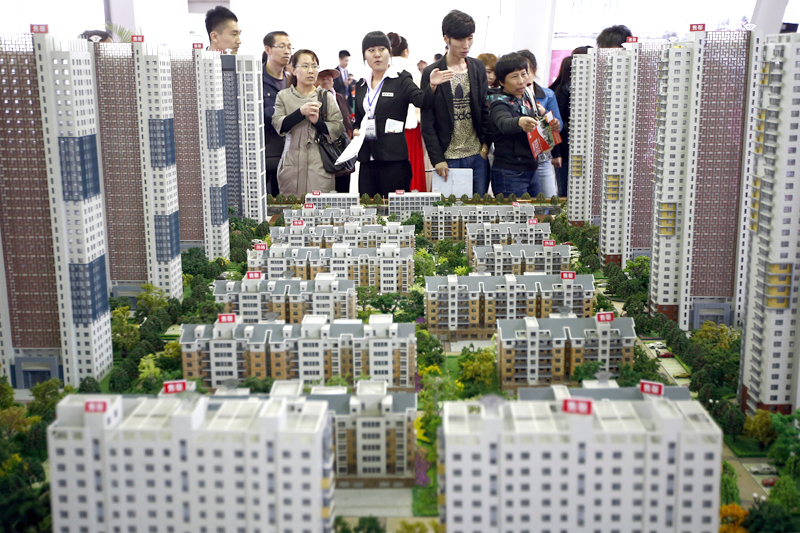 Author: Fan Gang, President, CDI
Author: Fan Gang, President, CDI
Editor’s Note: The 15th "China Reform Forum" was hosted by the China Society of Economic Reform in Beijing on December 2, 2017. The theme of the forum was "to learn from and implement the spirit of the 19th CPC Congress, study and make breakthroughs in the reform of key areas". Professor Fan systematically analyzed the necessity of the property long-term mechanism at the conference.
Despite that short-term policy may work under certain conditions, ultimately long-term mechanism must be established to stabilize the market. As seen in the current huge demand for properties, housing demand is far from exhaustion. The high rate of property ownership in China only reflects the underdeveloped rental market, not the exhausted demand. In addition to residential needs, there are also non-residential needs. Problem arises when people invest in property with small intent for letting, which is resulted from the bubble in the property market and the pursuit of value appreciation in properties. In the absence of a mechanism to increase the cost of property ownership, such demand has not been curbed. Therefore, the most important long-term mechanism on the demand side is property tax.
Property tax has three functions. First, it will increase the cost of ownership, and reduce investment demand. Second, it is the internal stabilizer of price fluctuations. Given the same tax rate, the tax on the property will vary based on the current value of the house. When housing price skyrockets, some people will choose to withdraw from the market or switch to smaller ones due to higher tax. This is fully reflected in other countries’ mechanisms. Third, currently, taxes paid upon purchasing the property included future public services such as environmental conservation and transportation maintenance. With the increase in land price and labor cost, the costs of these public services will also increase along with the economic development. Therefore, the current lump-sum tax upon purchase is unreasonable.
Property tax policy must be implemented rationally with a transitional period. For example, for the properties that have paid lump-sum tax upon purchase, property tax should be collected after a ten to twenty-year transitional period when the lump-sum is discounted to present value. Meanwhile low-income property tax deduction can be integrated into construction tax, or grants for suitable personnel which is similar to the minimum living security.
On the supply side, in terms of inhabitable area, China faces severe scarcity of land and its habitable area per person is one third of the world average, combined with other human factors such as regime, strategies, and policies, causing short supply of land and houses. Such circumstance is mainly reflected in the following four aspects. First, the current plot ratio in China is too low. More buildings should be constructed on the limited land to improve efficiency. Second, some local governments should be held responsible for failure to supply land when housing prices rise and its aftermath. Third, property developers acquire land at high prices while housing price is the derivatives of land premium. Four, the rental market is underdeveloped as the result of insufficient supply of affordable rental properties and inadequate legal system that protects the interest of both landlord and tenant.
Last but not least, land allocation system, specifically allocation between major and small cities, is a problem of divergence of urbanization strategy. In the past, the development of small cities was given priority. Small cities were granted large quantity of land while the supply of land to major cities was restricted. However, the majority of people migrated to major cities while middle-sized and small cities, especially third and fourth tier cities, are where the population outflows. Recently, China Development Institute conducted a study on industrial transfer. The central government had policies in place to encourage industrial transfer and identified over 60 cities to be the industrial transfer destinations. For over ten years, 87% of the transfer was to provincial capitals but barely to small cities. Since better services, infrastructure, human resources and logistics services are only available in major cities due to the agglomeration effect and cluster effect, various industries are brought into major cities along with numerous employment opportunities. Therefore, to pursue a better life, people have to migrate to major cities.
To improve the property system, market-oriented strategy is necessary. First, market based resource allocation should take effect, instead of government undertaking. Second, stabilized market does not entail fixed price. Growth of income and predetermined land supply indicates that the relative price of land is basically GDP. If GDP increases constantly, the land price will increase and then the housing price. As such, what truly needs to be stabilized is the proportion of income to housing price. Measures should be taken on both sides of supply and demand while long-term mechanism should be established to gradually achieve long-term market stability of supply and demand.








